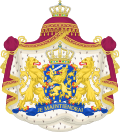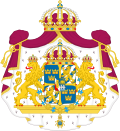You can help expand this article with text translated from the corresponding article in German. (September 2017)Click [show] for important translation instructions.
|
You can help expand this article with text translated from the corresponding article in Dutch. (September 2017)Click [show] for important translation instructions.
|


In heraldry, a mantle is a symbol of sovereign power and is generally reserved for royalty. In some cases, its use has also been granted to other nobles, in recognition of particular merits. In ordinary rendering, the mantle is usually crimson and lined with ermine.
Contents
Certain coats of arms may also display a pavilion (similar to a baldachin) surmounting the mantle. The pavilion is said to be the invention of the Frenchman Philip Moreau. [1] Some republics have displayed a mantle and pavillon in their coats of arms, contemporarily Serbia.
While common in continental European heraldry, the mantle and pavilion is not found in English or Scottish heraldry. [2]
Mantle and pavilion should not be confused with mantling.



















